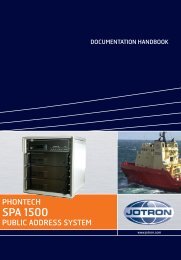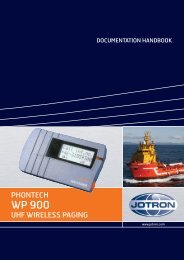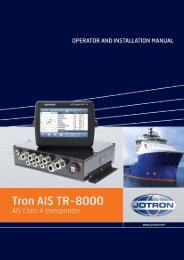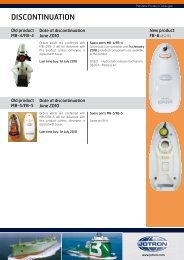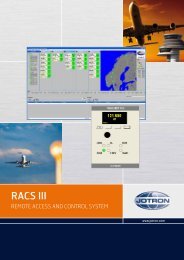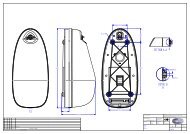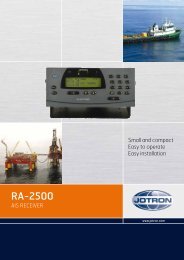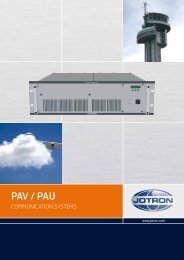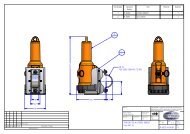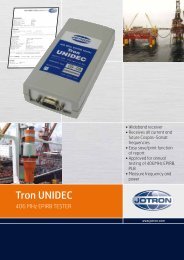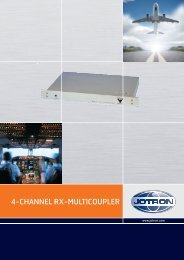Users Manual Tron SART20.pdf - Jotron
Users Manual Tron SART20.pdf - Jotron
Users Manual Tron SART20.pdf - Jotron
You also want an ePaper? Increase the reach of your titles
YUMPU automatically turns print PDFs into web optimized ePapers that Google loves.
USERS MANUAL<br />
<strong>Tron</strong> SART20<br />
www.jotron.com
www.jotron.com<br />
EC Declaration of Conformity, available at www.jotron.com<br />
Abbreviations and definitions<br />
EMC<br />
Electromagnetic Compatibility<br />
LED<br />
Light Emitting Diode<br />
SART<br />
Search and Rescue Transponder<br />
VHF<br />
Very High Frequency<br />
2<br />
84145_UM_SART20_J
www.jotron.com<br />
Amendment Records<br />
AMEND- INCORP. DATE PAGE(S) VERSION REASON<br />
MENT NO. BY FOR CHANGE<br />
1 ES 14.09.07 Total: 24 A New product<br />
2 ES 02.04.08 10, 15 B Added text<br />
3 ES 29.07.08 1 C Background<br />
4 ES 04.08.08 15,16 D<br />
Lifeboat bracket<br />
updated<br />
5 ES 14.08.08 9,13,21 E Battery label<br />
6 TH 12.02.09 10, 13-19, new tot. 28 F Brackets and layout<br />
7 ES 16.12.09 24 G Added text<br />
8 FIT 05.11.10 24-25 H Added information<br />
New pics on figure<br />
9 TH 01.02.11 15 I<br />
4.1.2b and 4.1.3<br />
10 TH 14.04.2011 Total 28 J Updated information<br />
84145_UM_SART20_J<br />
3
www.jotron.com<br />
The information in this book has been carefully checked and is believed to<br />
be accurate. However, no responsibility is assumed for inaccuracies.<br />
CAUTION!<br />
This equipment contains CMOS integrated circuits. Observe handling precautions<br />
to avoid static discharges which may damage these devices. <strong>Jotron</strong><br />
AS reserves the right to make changes without further notice to any<br />
products or modules described herein to improve reliability, function or design.<br />
<strong>Jotron</strong> AS does not assume any liability arising out of the application<br />
or use of the described product.<br />
WARNING / IMPORTANT<br />
<strong>Jotron</strong> AS is a prime manufacturer of safety equipment designed for rescue<br />
of human lives and their property. For safety equipment to be effective in<br />
line with the design parameters it is important that they are handled, stowed<br />
and maintained in compliance with the manufacturers instructions. <strong>Jotron</strong><br />
AS cannot be held responsible for any damage caused due to incorrect use<br />
of the equipment or breach of laid down procedures or for failure of any<br />
specific component or other parts of the equipment.<br />
The chapter covering battery replacement (6.2.1) is added for information<br />
only. <strong>Jotron</strong> AS does not take any responsibility for improper disassembling/<br />
assembling of the beacon. We strongly recommend all service to be done<br />
by authorized <strong>Jotron</strong> agents. In addition to normal service, <strong>Jotron</strong> agents<br />
have the necessary equipment and knowledge to test the operational functions<br />
of the beacon. Non-original maintenance and/or service parts may<br />
destroy the equipment function and performance.<br />
4<br />
84145_UM_SART20_J
www.jotron.com<br />
Table of contents<br />
1 GMDSS Requirements 7<br />
1.1 General description 8<br />
1.2 <strong>Tron</strong> SART20 features 9<br />
2 Technical specifications 10<br />
2.1 Electrical specifications 10<br />
2.2 Mechanical specification 10<br />
3 Functional description 11<br />
3.1 General 11<br />
3.1.1 <strong>Tron</strong> SART20 electronic assembly 11<br />
3.1.2 Battery module 12<br />
3.1.3 Bottom lid 12<br />
4 Installation 13<br />
4.1 Brackets 13<br />
4.1.1 Wall bracket 13<br />
4.1.2 Lifeboat bracket (optional) 14<br />
4.1.3 Using the telescopic pole 16<br />
5 Operation 17<br />
5.1 Activating <strong>Tron</strong> SART20 17<br />
5.1.1 Deactivating <strong>Tron</strong> SART20 17<br />
5.2 Usage in lifeboat/life raft 17<br />
5.2.1. SART pocket 18<br />
5.2.2. Life raft mounting strap 18<br />
5.2.3. SART pole mounting 18<br />
5.2.4. 10 m rope slide 19<br />
5.3 Test of <strong>Tron</strong> SART20 21<br />
6 Maintenance and troubleshooting 23<br />
6.1 Maintenance 23<br />
6.2 Service 23<br />
6.2.1 Replacing the battery module 24<br />
6.2.2 Battery disposal 26<br />
6.2.3 Incineration 26<br />
6.2.4 Land filling 26<br />
6.2.5 Recycling 26<br />
7 Spare parts/Accessories 26<br />
8 Service agents 27<br />
84145_UM_SART20_J<br />
5
www.jotron.com<br />
Battery safety data sheet<br />
(Form: EEC directive 91/155)<br />
(2) SAFETY ADVICE<br />
S2 Keep out of reach of children.<br />
S8 Keep container dry.<br />
S26 In case of contact with eyes, rinse immediately with plenty of water<br />
and seek medical advice.<br />
S43 In case of fire, use D type extinguishers. Never use water.<br />
S45 In case of accident or if you feel unwell, seek medical advice immedi<br />
ately (show the label where possible).<br />
(3) FIRST AID MEASURES<br />
In case of contact of cell contents with eyes, flush immediately with water for<br />
15 min. With skin, wash with plenty of water and take off contaminated clothes.<br />
If inhaled, remove from exposure, give oxygen, and seek medical advice.<br />
(4) FIRE-FIGHTING MEASURES<br />
Extinguishing media<br />
Suitable: Type D fire extinguishers<br />
Not to be used: Water - CO2 - Halon, dry chemical or foam extinguishers<br />
Special exposure hazards<br />
Generation of chlorine, sulphur dioxide, disulphur dichloride during<br />
thermal decomposition.<br />
Special protective equipment<br />
Use protective working boots, rubber apron and safety glasses with side shields.<br />
6<br />
84145_UM_SART20_J
www.jotron.com<br />
1 GMDSS REQUIREMENTS<br />
<strong>Jotron</strong> GMDSS products are manufactured and approved to be compliant with relevant IMO/ SOLAS (Safety of<br />
Life at Sea ) Regulations and requirements. The SOLAS GMDSS regulations are structured such that all GMDSS<br />
ships are required to carry a minimum set of equipment, with (basically) more equipment being required the<br />
further the ship travels from land. GMDSS requirement for SART (Search and Rescue Locating Device) according<br />
to SOLAS :<br />
Chapter III, Regulation 6<br />
2.2 Search and rescue locating devices<br />
At least one search and rescue locating device shall be carried on each side of every passenger ship and of every<br />
cargo ship of 500 gross tonnage and upwards. At least one search and rescue locating device shall be carried on<br />
every cargo ship of 300 gross tonnage and upwards but less than 500 gross tonnage. Such search and rescue<br />
locating devices shall conform to the applicable performance standards not inferior to those adopted by the<br />
Organization*. The search and rescue locating devices** shall be stowed in such location that they can be rapidly<br />
placed in any survival craft other than the liferaft or liferafts required by regulation 31.1.4. Alternatively one search<br />
and rescue locating device shall be stowed in each survival craft other than those required by regulation 31.1.4.<br />
On ships carrying at least two search and rescue locating devices and equipped with free-fall lifeboats one of the<br />
search and rescue locating devices shall be stowed in a free-fall lifeboat and the other located in the immediate<br />
vicinity of the navigation bridge so that it can be utilized on board and ready for transfer to any of the other<br />
survival craft.<br />
__________<br />
* Refer to the Recommendation on performance standards for survival craft radar transponders for use in search<br />
and rescue operations, adopted by the Organization by resolution MSC.247(83) (A.802(19)), as amended)<br />
and the Recommendation on performance standards for survival craft AIS Search and Rescue transmitter (AIS<br />
SART), adopted by the Organization by resolution MSC.246(83).<br />
** One of these search and rescue locating devices may be the search and rescue locating device required by<br />
regulation IV/7.1.3.<br />
Regulation 26 - Additional requirements for ro-ro passenger ships<br />
2 Liferafts<br />
2.5 Liferafts carried on ro-ro passenger ships shall be fitted with a search and rescue locating device in the ratio<br />
of one search and rescue locating device for every four liferafts. The search and rescue locating device shall be<br />
mounted inside the liferaft so its antenna is more than one metre above the sea level when the liferaft is deployed,<br />
except that for canopied reversible liferafts the search and rescue locating device shall be so arranged as to be<br />
readily accessed and erected by survivors. Each search and rescue locating device shall be arranged to be manually<br />
erected when the liferaft is deployed. Containers of liferafts fitted with search and rescue locating devices<br />
shall be clearly marked.”<br />
Chapter IV, Regulation 7- Radio Equipment- General<br />
1 Every ship shall be provided with:<br />
.3 A search and rescue locating device capable of operating either in the 9 GHz band or on<br />
frequencies dedicated for AIS, which:<br />
.3.1 shall be so stowed that it can be easily utilized; and<br />
.3.2 may be one of those required by reg. III/6.2.2 for a survival craft<br />
<strong>Tron</strong> SART20 is also compliant with relevant sections in these regulations/requirements:<br />
• SOLAS 74 as amended, Regulation III/6.2.2, IV/7.1.3, IMO Res. MSC.97 (73) 14.7.1.3, MSC.247(83), IMO Res.<br />
A.530 (13), IMO Res. A.802 (19), IMO Res. A.694 (17), ITU-R M.628-3 (11/93), IEC 61097-1:1992, IEC 61097-<br />
1(2007), IEC 60945:1996 and IEC 60945 ed.4:2002<br />
• IMO Resolutions MSC.256(84)<br />
• COMSAR/Circ.32<br />
• European Directive 2009/26/EC<br />
• Other national certifications/requirements<br />
84145_UM_SART20_J<br />
7
www.jotron.com<br />
1.1 GENERAL DESCRIPTION<br />
<strong>Tron</strong> SART20 is emergency equipment consisting of:<br />
1. <strong>Tron</strong> SART20 radar transponder.<br />
2. Mounting rope for life rafts / life boats.<br />
The 9 GHz radar transponder type <strong>Tron</strong> SART20 is developed by <strong>Jotron</strong> AS to<br />
meet the rules and regulations for use on vessels and life rafts in the maritime<br />
service. <strong>Tron</strong> SART20 meets the specifications for 9 GHz radar transponders<br />
for use in search and rescue operations at sea.<br />
The operating range of the <strong>Tron</strong> SART20 is up to 30 nautical miles, depending<br />
on the height of the electronic unit and the radar height of the search and rescue<br />
unit (sea or airborne). With a radar height of 20m and the <strong>Tron</strong> SART20<br />
placed at 1m above sea level, the range will be up to 10 nautical miles. <strong>Tron</strong><br />
SART20 is buoyant, however to obtain maximum performance the transponder<br />
should be placed in a vertical position and as high up as possible in order to<br />
achieve maximum coverage.Several mounting brackets and mounting aids are<br />
available to ensure correct mounting and use of the radar transponder.<br />
The purpose of the <strong>Tron</strong> SART20 is to perform a secondary alarm when search<br />
and rescue units are searching for a life raft / lifeboat in distress. The <strong>Tron</strong><br />
SART20 will help the units to pinpoint exactly where the distressed boat is located<br />
in a larger area. This is done with the help of the radar on the searching<br />
ship or helicopter.<br />
When the <strong>Tron</strong> SART20 is interrogated (hit) by a radar signal, it will immediately<br />
start to transmit a number of sweeps covering the complete maritime 3 cm<br />
radar band. These sweeps are detected on the radar screen and are used to<br />
navigate directly towards the distressed life raft, for details on radar display see<br />
chapter 5.3. Maximum distance to a ship will normally be about 10 nm and approximately<br />
30nm to a helicopter, dependent on the helicopters altitude. The<br />
transponder will not give any alarms further away than this.<br />
The primary alarm will usually be an Emergency Position Indicating Radio<br />
Beacon (EPIRB) or distress call on VHF / HF - manual or via digital selcall.<br />
The <strong>Tron</strong> SART20 should be activated immediately after activation of the EPIRB<br />
or by instruction from the rescue control centre.<br />
8<br />
84145_UM_SART20_J
www.jotron.com<br />
The batteries of the <strong>Tron</strong> SART20 will last at least 96 hours in standby after<br />
activation and then minimum 8 hours of continuous operation.<br />
Although the transponder does not send any alarm via satellite, VHF or other<br />
radio communication, the use should be limited to short tests and emergency<br />
situations. This is to save battery capacity in case of a situation where the transponder<br />
is needed.<br />
1.2 <strong>Tron</strong> SART20 features<br />
Watertight:<br />
<strong>Tron</strong> SART20 is watertight to a depth of minimum 1 meter.<br />
Buoyant:<br />
<strong>Tron</strong> SART20 is buoyant in case the transponder is accidentally dropped into<br />
the water. To increase coverage the SART20 should always be held or mounted<br />
as high as possible.<br />
Rugged design:<br />
The <strong>Tron</strong> SART20 will withstand a drop from 20 meters into the water. It is resistant<br />
to seawater, oil and sunlight.<br />
Handling:<br />
<strong>Tron</strong> SART20 is designed for easy operation, with a brief operating instruction<br />
printed on the unit. It comes standard with a 10 meter rope and a shackle hook<br />
to be used for hanging the SART20 on the inside of a life raft.<br />
Indicators:<br />
<strong>Tron</strong> SART20 is equipped with an LED and a built in buzzer to indicate operation.<br />
The LED will normally give a flash each 4 seconds to show that the <strong>Tron</strong> SART20<br />
is activated.<br />
When a search and rescue unit is approaching the buzzer will sound each time<br />
the SART20 is hit by the radar. A continuous sound from the buzzer means that<br />
the ship or helicopter is close to the <strong>Tron</strong> SART20 and the radar is hitting the<br />
<strong>Tron</strong> SART20 continuously.<br />
Battery unit.<br />
The battery module is to be replaced every<br />
5.year. A battery expiry label on the <strong>Tron</strong><br />
SART20 housing displays the expiry date. A<br />
new battery comes complete with cable and<br />
connector.<br />
Figure 1.1, Battery expiry label<br />
84145_UM_SART20_J<br />
9
www.jotron.com<br />
2 TECHNICAL SPECIFICATIONS<br />
2.1 ELECTRICAL SPECIFICATIONS<br />
Frequency:<br />
X-band (3 cm) (9.2 - 9.5 GHz)<br />
Temperature range: Operating: -20 to +55°C<br />
Storage: -30 to +65°C<br />
Radiated power: > 400 mW e.i.r.p (+26 dBm)<br />
Sweep type:<br />
12 sweep sawtooth type<br />
Forward 7.5 us ±1 ms<br />
Return 0.4 us ±0.1 ms<br />
Starts with return sweep.<br />
Receive sensitivity: Better than -50 dBm e.r.s.<br />
Response delay: Max 0.5 ms<br />
Antenna pattern: Horizontal polarization.<br />
Omni directional radiation in the horizontal plane.<br />
Greater than ±12.5 degrees elevation angle in the<br />
vertical plane.<br />
Battery:<br />
Lithium metal 7,2V/3600 mAh, 5 years service life.<br />
Battery capacity: 96 hours standby +8 hours continuous operation<br />
when activated by a radar with 1 kHz prf at -20°C.<br />
5 years storage.<br />
2.2 MECHANICAL SPECIFICATION<br />
Materials used:<br />
- Transponder housing: Glass reinforced polycarbonate<br />
- Bracket: Anodized aluminum.<br />
Transponder dimensions:<br />
Max diameter: 89 mm<br />
Length: 250 mm<br />
Weight: 482 g<br />
Transponder with standard storage bracket:<br />
Max diameter: 90 mm<br />
Length: 250 mm<br />
10<br />
84145_UM_SART20_J
www.jotron.com<br />
3 FUNCTIONAL DESCRIPTION<br />
3.1 GENERAL<br />
<strong>Tron</strong> SART20 consists of a housing sealed at the lower end with a bottom lid<br />
and may be split into the following main parts:<br />
1. Bottom lid.<br />
2. Housing with <strong>Tron</strong> SART20 electronic assembly and battery module.<br />
The housing is made of glass reinforced polycarbonate.<br />
1 2<br />
Figure 3.1, <strong>Tron</strong> SART20 disassembled<br />
3.1.1 TRON SART20 ELECTRONIC ASSEMBLY<br />
<strong>Tron</strong> SART20 electronic assembly is inserted into the <strong>Tron</strong> SART20 housing.<br />
It consists of the transceiver module and antenna.<br />
1. Transceiver Board in metal box<br />
2. Antenna (9GHz).<br />
1 2<br />
Figure 3.1.1 <strong>Tron</strong> SART20 electronic assembly<br />
84145_UM_SART20_J<br />
11
www.jotron.com<br />
3.1.2 BATTERY MODULE<br />
The battery module is inserted into the <strong>Tron</strong> SART20 housing.<br />
A battery expiry label on the <strong>Tron</strong> SART20 housing displays the battery expiry<br />
date.<br />
A new battery module comes complete with cable and connector and can be<br />
changed by opening the bottom lid of the <strong>Tron</strong> SART20, see description in<br />
chapter 6<br />
Figure 3.1.2 TRON SART20 BATTERY<br />
- module without cable and connector<br />
3.1.3 BOTTOM LID<br />
The Bottom lid includes four items:<br />
Battery expiry<br />
label<br />
1. The winder hook<br />
2. The screw ring<br />
3. The light tower<br />
4. The O-ring<br />
2<br />
1<br />
3<br />
4<br />
Figure 3.1.3 Bottom lid<br />
12<br />
84145_UM_SART20_J
www.jotron.com<br />
4 INSTALLATION<br />
<strong>Tron</strong> SART20 can be mounted several ways; Near the vessels emergency exit,<br />
normally in the wheelhouse at the starboard or port exit (or both, depending<br />
of requirements) and inside liferaft or lifeboat. (See ”GMDSS requirements in<br />
chapter 1.<br />
4.1 BRACKETS<br />
There are 3 different mounting brackets available.<br />
1. Wall bracket<br />
2. Lifeboat bracket (optional)<br />
3. Pole (optional)<br />
4.1.1 WALL BRACKET<br />
A wall bracket is delivered with the <strong>Tron</strong> SART20 and should be used for storage<br />
of the transponder. The bracket should preferably be mounted in a vertical<br />
position and in a place where the <strong>Tron</strong> SART20 is easily available in case of an<br />
emergency.<br />
Figure 4.1.1a, wall bracket.<br />
Figure 4.1.1b, <strong>Tron</strong> SART20<br />
mounted in wall bracket.<br />
The bracket should be mounted with four screws (Ø 4 mm).<br />
84145_UM_SART20_J<br />
13
www.jotron.com<br />
<strong>Tron</strong> SART20 main unit<br />
The state when inserted<br />
into the wall bracket<br />
Clip<br />
Insert the clip of the<br />
SART20 main unit into the<br />
wall bracket from a top<br />
Wall<br />
Wall bracket:<br />
- For mounting, use 4 mm<br />
screws or wood screws,<br />
depending on the wall type<br />
Figure 4.1.1c, Installation diagram of the SART20 main unit and the wall bracket<br />
4.1.2 LIFEBOAT BRACKET (optional)<br />
The outdoor lifeboat bracket should be mounted vertically on the roof of the<br />
lifeboat (as high as possible). <strong>Tron</strong> SART20 shall not be perminantly stored in<br />
this bracket if mounted outside a freefall lifeboat, but moved to this bracket<br />
after lifeboat is deployed in water.<br />
Activate the transponder and put it into the bracket. Secure the transponder<br />
to the bracket. The bracket will fit a pipe with a maximum diameter of 50mm.<br />
14<br />
84145_UM_SART20_J
www.jotron.com<br />
Figure 4.1.2a, Lifeboat bracket<br />
Figure 4.1.2b, <strong>Tron</strong> SART20 to<br />
put into lifeboat bracket<br />
Figure 4.1.2c, Examples of pipe mounting<br />
6,3<br />
5,3<br />
Figure 4.1.2d, <strong>Tron</strong> SART20 lifeboat bracket<br />
Figure 4.1.2e Example of Mounting<br />
the Bracket on Interior and Exterior<br />
Walls of a Lifeboat<br />
84145_UM_SART20_J<br />
15
www.jotron.com<br />
4.1.3 USING THE TELESCOPIC POLE<br />
Figure 4.1.3 <strong>Tron</strong> SART20 with telescopic pole attached.<br />
A telescopic pole can be used to extend the height of the <strong>Tron</strong> SART20, inside<br />
or outside the life raft/boat. Simply extend the attached pole to the full length<br />
(app. 1,2m from the top of the <strong>Tron</strong> SART20). Make sure that the rod is locked<br />
by pulling hard when it is fully extended. The rod can now be fastened or held<br />
by a person. Ensure the rod is held as vertical as possible when activating the<br />
<strong>Tron</strong> SART20.<br />
May be used for mounting inside a liferaft (optional).<br />
16<br />
84145_UM_SART20_J
www.jotron.com<br />
5 OPERATION<br />
<strong>Tron</strong> SART20 should be installed according to chapter 1 and 4, and in a distress<br />
situation, the <strong>Tron</strong> SART20 should be carried from it´s storage position to the<br />
liferaft/lifeboat<br />
5.1 ACTIVATING TRON SART20<br />
1. Break seal at switch.<br />
2. Pull locking pin and make sure that the switch enters the “ON” position. An<br />
audible “BEEP” will be heard and the indicator led will start to flash every 4 sec<br />
3. Place (or hold) the transponder in a vertical position as high as possible.<br />
When the <strong>Tron</strong> SART20 is within range of an active 3 cm radar x-band, the<br />
internal loudspeaker will be activated. A handheld VHF radio should<br />
now be used to establish contact with the approaching boat or helicopter.<br />
After activating the <strong>Tron</strong> SART20, it shall be mounted in lifeboat/liferaft as described<br />
in ch. 5.3.<br />
5.1.1 DEACTIVATING TRON SART20<br />
1. Move the switch to the “OFF” position.<br />
2. Replace the locking pin.<br />
5.2 EXAMPLES OF USAGE IN LIFEBOAT/LIFERAFT<br />
Figure 5.2.1, How to mount <strong>Tron</strong> SART20 to a life raft<br />
84145_UM_SART20_J<br />
17
www.jotron.com<br />
From figure 5.2.1 above, left to right:<br />
1. Using ”life raft mounting strap” (or optionally the 10m lanyard)<br />
2. SART pocket<br />
3. Pole<br />
5.2.1 SART POCKET<br />
There are different ways of mounting a <strong>Tron</strong> SART20 in an inflatable Life Raft:<br />
It is often a SART pocket where the <strong>Tron</strong> SART20 may be lifted to the canopy<br />
after deploying the raft (See figure 5.2.1, middle)<br />
• Put the SART20 into the SART pocket.<br />
• Lift the pocket by it´s rope to the canopy<br />
5.2.2 LIFE RAFT MOUNTING STRAP<br />
We can supply a ”SART Life-raft mounting strap” (partno. 85120) as seen on<br />
the attached pictures to be mounted to the inflatable canopy.<br />
• Attach the strap as seen on picture above<br />
• Fasten the other end to the canopy as seen on figure 5.2.1<br />
5.2.3 SART POLE MOUNTING<br />
You may use the 1m Pole arrangement (partno. 82900) (See figure 5.2.1,<br />
right)<br />
• Attach the pole to SART20<br />
• Extend the pole to it´s full length and make sure it is ”locked”<br />
• Lift it up through the tent airtube (if available) and secure using the liferafts<br />
mounting for SART pole (strap, rope etc.)<br />
18<br />
84145_UM_SART20_J
www.jotron.com<br />
5.2.4 10 M REEL WITH LANYARD<br />
The last solution is to use the 10m lanyard (see figure 5.2.1, left) and picture<br />
below.<br />
• Remove the lanyard reel as seen on picture above<br />
• Roll out the lanyard from the reel<br />
• Thread it through the fastening ring of the top of the SART20<br />
• Lift SART20 to the canopy and fasten as seen on figure 5.2.1, left<br />
84145_UM_SART20_J<br />
19
www.jotron.com<br />
20<br />
84145_UM_SART20_J
www.jotron.com<br />
5.3 TEST OF TRON SART20<br />
Test of the <strong>Tron</strong> SART20 is done using the ships own 3 cm X-band radar. The<br />
radar display will show different patterns depending on the range to the transponder.<br />
See Figure 5.3a, b and c for details of the radar display. Note that the<br />
examples shown are typical and will vary with the radar performance (height,<br />
power output and sensitivity).<br />
With the transponder located close to the radar the signals will appear as rings<br />
on the radar display. The rings may be broken in some sectors, depending on<br />
ship construction and other obstacles, and does not indicate an error in the<br />
transponder. Placing it further away will reduce the signals to 12 dots on the<br />
radar display, showing the direction to the transponder.<br />
Modern radars often have special function that will optimize reception of radar<br />
SART, either in TEST or ON. If the Radar has such function, the Radar is detuned<br />
out of best tuning condition, and erases or weakens all normal radar echoes,<br />
but SART echoes are not erased because SART frequencies scans over all the<br />
X-band from 9.2 to 9.5 GHz. When this function is selected on the radar, a text<br />
”SART” is shown at the bottom of the display.<br />
Note! Make sure that the SART feature is turned off when SART detection is no<br />
longer necessary<br />
1. Hold the switch on the <strong>Tron</strong> SART20 in the “TEST” position.<br />
2. Simultaneously a person should observe the radar display to check for<br />
correct pattern. The radar should be set for a 10 nm range.<br />
3. The test should preferably be done in open sea to avoid interference on the<br />
radar display from land echoes.<br />
4. Alternatively, a radar of a nearby ship can be used to test the transponder.<br />
A ship to ship VHF channel should then be used to confirm operation.<br />
84145_UM_SART20_J<br />
21
www.jotron.com<br />
Figure 5.3a<br />
Typical display when <strong>Tron</strong> SART20 is located<br />
near (2 nm) from the<br />
radar. Radar range is 10 nm. Rings are at 2<br />
nm.<br />
22<br />
84145_UM_SART20_J
www.jotron.com<br />
CAUTION!<br />
While the <strong>Tron</strong> SART20 is activated it will respond to any 3 cm radars within<br />
range. Tests must be made as short as possible (5 min) to avoid interference<br />
and to avoid wasting battery capacity.<br />
6 MAINTENANCE AND TROUBLESHOOTING<br />
6.1 MAINTENANCE<br />
<strong>Tron</strong> SART20 requires the following maintenance:<br />
At least every 6. month.<br />
The transponder should be taken out of its bracket and tested against a radar,<br />
using the procedure in chapter 5.3. Either the ships own radar could be used or<br />
the radar of a nearby ship. Note that the self test use the internal battery and<br />
will reduce the operational lifetime of the equipment - therefore the test should<br />
be limited to not more than once every month.<br />
Every 5. year.<br />
The battery unit must be replaced every 5 year. Storage of batteries over a long<br />
period of time will reduce their capacity. To ensure long and reliable operation<br />
the battery unit must be replaced every 5 year. The battery replacement can be<br />
performed on board using the procedure in chapter 6.2.1.<br />
6.2 SERVICE<br />
Warranty Service<br />
All goods sold by the Company are warranted to be free from defect in workmanship<br />
and material for the period of five (5) years from the date of purchase<br />
from <strong>Jotron</strong>. For further information, see pos.6 “Guarantee” in our Terms and<br />
Conditions of Sale.<br />
Provided that the unit(s) returned for repair is under warranty, man-hour cost<br />
and material cost will be covered by <strong>Jotron</strong>. This is not valid if the customer<br />
has tried to repair, modify or rebuild the unit, or if the unit has been exposed to<br />
environmental conditions outside the specifications for the unit. If the unit is in<br />
need of repair, please return it carriage paid to the agent that you purchased it<br />
from. Additional costs not related to repair/replacement of the unit will not be<br />
covered.<br />
84145_UM_SART20_J<br />
23
www.jotron.com<br />
Out of Warranty Service<br />
For defects arising from normal wear and tear after 12 months of operation,<br />
limited to 18 months from <strong>Jotron</strong> AS, normal service conditions will apply. For<br />
details see: www.jotron.com<br />
6.2.1 REPLACING THE BATTERY MODULE<br />
Below is a description on how to change batteries on AIS-SART<br />
Dissassembly:<br />
Twist the rubber grip<br />
anti-clockwise to<br />
remove the lid<br />
It might be difficult<br />
to remove the lid. If<br />
so, remove the rubber<br />
grip first<br />
And then twist off<br />
the lid<br />
Opened<br />
Rubber holder below<br />
battery and electronics<br />
removed<br />
Pull out the battery<br />
Pull out the cable from connector<br />
Remove old Silaca<br />
gel bags<br />
See these pictures in colours on www.jotron.com<br />
24<br />
84145_UM_SART20_J
www.jotron.com<br />
Assembly:<br />
Install the new battery.<br />
Make sure the<br />
cable is within the<br />
guide<br />
Connect cable to<br />
electronics,<br />
black= left,<br />
red= right<br />
Add 2x5 g Silica<br />
gel bags<br />
Mount rubber<br />
holder<br />
Remove old O-ring<br />
using a Credit Card<br />
Use acid-free<br />
Vaseline on the<br />
new O-ring<br />
Fit the new<br />
O-ring<br />
Reinstall lid- tighten<br />
without tools<br />
Replace the rubber<br />
grip<br />
Assembly completed<br />
See these pictures in colours on www.jotron.com<br />
84145_UM_SART20_J<br />
25
www.jotron.com<br />
6.2.2 BATTERY DISPOSAL<br />
Dispose in accordance with applicable regulations, which vary from country<br />
to country.(In most countries, the disposal of used batteries is regulated and<br />
end-users are invited to dispose of them correctly, through non-profit organizations,<br />
mandated by local governments or organized on a voluntary basis<br />
by professionals).Lithium batteries should have their terminals insulated prior<br />
to disposal.<br />
6.2.3 INCINERATION<br />
Incineration should never be performed by battery users but by trained professionals<br />
in authorized facilities with proper gas and fumes treatment.<br />
6.2.4 LAND FILLING<br />
Leachability regulations (mg/l)<br />
Component Leachability EC limit EPA Other*<br />
Iron 100 5<br />
Nickel 100 500 2 0,5<br />
* Applicable to France<br />
6.2.5 RECYCLING<br />
Send to authorized recycling facilities, through a licensed waste carrier.<br />
7 SPARE PARTS/ACCESSORIES<br />
83010 <strong>Tron</strong> SART20 Main unit<br />
84065 Lifeboat bracket<br />
82900 Pole bracket<br />
82120 Life raft mounting strap<br />
82615 Battery, <strong>Tron</strong> SART20, 5 years maintenance kit<br />
82746 Bulkhead bracket<br />
26<br />
84145_UM_SART20_J
www.jotron.com<br />
8 SERVICE AGENTS<br />
Please look at www.jotron.com for Marine Service Agents.<br />
<strong>Jotron</strong> Group subsidiary companies:<br />
<strong>Jotron</strong> UK Ltd.<br />
Crosland Park<br />
Cramlington<br />
NE23 1LA<br />
United Kingdom<br />
Tel +44 1670 712000<br />
Fax +44 1670 590265<br />
E-mail: sales@jotron.com<br />
<strong>Jotron</strong> Asia Pte. Ltd.<br />
Changi Logistics Center<br />
19 Loyang Way #04-26<br />
Singapore 508724<br />
Tel +65 65426350<br />
Fax +65 65429415<br />
E-mail: sales@jotron.com<br />
<strong>Jotron</strong> USA, Inc.<br />
10645 Richmond Avenue, Suite 170<br />
Houston, TX 77042<br />
USA<br />
Tel +1 713 268 1061<br />
Fax +1 713 268 1062<br />
E-mail: sales@jotron.com<br />
84145_UM_SART20_J<br />
27
www.jotron.com



